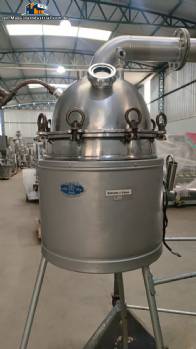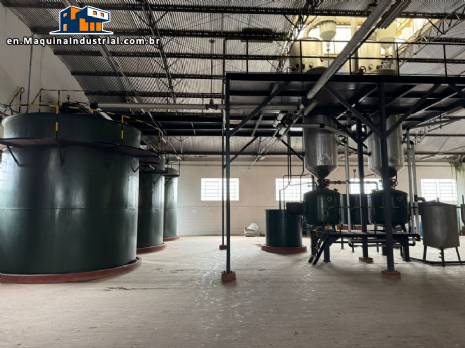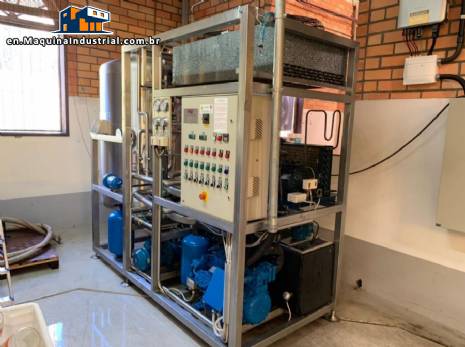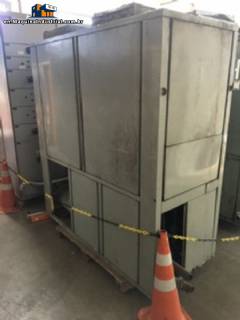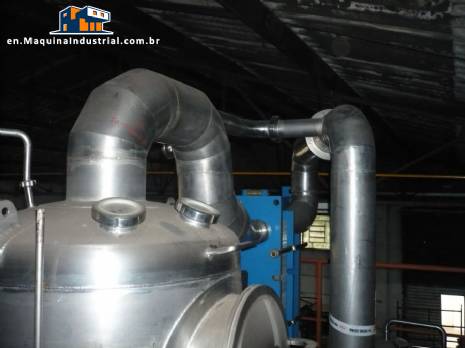1. Equipment Operating Principle
1.1 Basic Structure
A typical industrial vacuum-heated concentrator consists of:
A concentration vessel (reactor or tank) whose walls or outer jacket are heated (heated by electrical resistance or steam or thermal oil)—this allows heat to be transferred to the liquid product inside.
The vessel is connected to a vacuum pump to reduce the pressure inside or at the evaporation head, thus lowering the boiling point of the liquid or solvent.
A condenser (or set of exchangers) cools the vapors escaping from the tank, condensing them for recovery (or disposal) of the solvent/vapor, or even to recover the essence or solvent/alcohol.
A vacuum system plus isolation valves, pressure gauges, temperature control, and discharge or reception systems for the concentrated liquid and condensate/vapor.
In many cases, an agitator or scraper inside the tank prevents sedimentation, crusting, increased viscosity, product "burning," or adhesion to the walls. Examples of scraper concentrators are used for high-viscosity products.
1.2 Thermal and Vacuum Operation
By applying a vacuum (reducing the pressure to, for example, <100 mbar or even lower), the boiling point of the solution or solvent also decreases. This means we can evaporate or concentrate liquids at lower temperatures, which is crucial when treating heat-sensitive materials—flavors, pharmaceutical extracts, vitamins, and volatile solvents.
Heating through the jacket or resistance provides the heat needed to generate vapor in the liquid. The heating layer must be uniform to avoid hot spots that would degrade the product. In industrial systems, it is common to use stainless steel materials (304, 316L) and sanitary finishes to meet GMP or cosmetic standards.
The condenser collects the generated vapor; this way, the system is closed or nearly closed to the atmosphere, maintaining a vacuum and reducing losses. It also allows the recovery of solvents (alcohol, ethanol, etc.) that can be reused, and avoids the vaporization of valuable aromas or compounds into the atmosphere. Some systems are built for the recovery of solvents or alcohols.
The thermal jacket or resistance heating allows for more precise temperature control—important to prevent degradation of sensitive compounds. The vacuum system lowers the boiling point, thus reducing the need for high temperatures. The condensation system maintains process efficiency and environmental safety.
1.3 System Advantages
Low-temperature evaporation: reduces the risk of thermal degradation of sensitive compounds (aromas, extracts, vitamins, cosmetics) by combining moderate heating and reduced pressure.
Higher yield and quality: better preserves the aroma profile or activity of the compounds (less losses due to oxidation or uncontrolled volatilization). A real-life case cited reports that the essential oil industry uses vacuum distillation to maintain purity and aroma.
Busch Vacuum Solutions
Solvent or alcohol recovery: if the system is designed for this purpose, it reduces costs and environmental impact.
Process control and standardization: with vacuum, controlled heating, it allows for standardization of the degree of concentration, remaining solids, viscosity, etc.
Compatible with industrial standards (GMP, hygiene, stainless steel, CIP cleaning): many equipment are designed for pharmaceutical, cosmetic, or food use.
1.4 Engineering Considerations
Materials of construction: parts in contact with the product, usually 316L stainless steel or similar, sanitary finish, vacuum tightness, special gaskets (e.g., welds, flanges, sight glasses, vacuum valves).
Vacuum control: suitable vacuum pump (liquid ring, vane pump, dry screw pump) to achieve the desired pressure level; instrumentation for measuring vacuum, liquid thermometers, vacuum gauges. Example: 0.01 mbar in vacuum ovens for electronics/pharmaceuticals.
Jacket or resistance heating: dimensioning of the exchange area, thermal behavior, uniformity, avoiding hotspots, ensuring that the liquid does not “burn” or lift off the wall. In high-viscosity applications, a scraping system may be used on the inner wall to maintain heat transfer.
Steam condenser: usually a shell-tube or coil heat exchanger, designed for the expected steam loads, type of return fluid (water, glycol, etc.). Must be compatible with solvents or organic vapors, if applicable.
Discharge/receiving system: condensate receiving tank, vapor-liquid separator, handling valves, CIP cleaning system, or maintenance access.
Safety and quality: relief valves, pressure gauges, inert gas purging if necessary, ATEX compliance for flammable vapors, data logging, sanitary cleaning, etc.
2. Industrial applications of the design
Vacuum Heated Concentrator
Below are some areas and products where this type of equipment is frequently used, with a technical explanation of its suitability.
2.1 Flavor/Fragrance/Essential Oil Industry
Extraction or concentration of essential oils from citrus fruits, flowers, herbs, and spices. For example, Capua 1880 uses vacuum technology in distillers for citrus essential oils to maintain the highest quality.
Concentration of natural extracts for use in perfumery or food: the vacuum reduces the boiling point and preserves volatile aromatic components without degrading or oxidizing them.
Recovery of solvents/alcohols after aroma extraction: for example, when an aromatic extract is obtained with solvent or ethanol, the concentrator can evaporate and recover the solvent under vacuum.
Production of concentrated food flavors, essences, and oils for cosmetics.
Specific techniques: film-fining, continuous-flow or batch concentration, use of a heated jacketed tank + vacuum to reduce temperature and preserve aroma. Examples of equipment for this use: juice or herbal extract concentrator, vacuum concentrator for herbs and oils.
2.2 Pharmaceutical Industry
Concentration of plant extracts or liquid pharmaceuticals (herbals, nutraceuticals), where the preservation of active compounds is critical.
Solvent recovery in the synthesis or purification of APIs (active pharmaceutical ingredients). The vacuum process helps remove residual solvents without exposing the product to high temperatures.
Purification processes where the solvent volume is reduced for subsequent crystallization or drying.
Production of syrups, concentrated pharmaceutical liquids, and oral formulations that require the removal of some of the water or solvent. Examples of equipment include vacuum concentrators – pharmaceutical manufacturing & processing equipment with a temperature range of 45–60°C.
In pharmaceutical cosmetics (bioactives, extracts, vitamins), the use of gentle concentration preserves the integrity of the active ingredients.
2.3 Cosmetics/Personal Care Products
Production of essences, concentrated botanical extracts used in cosmetics or perfumes.
Removal of water or solvent to produce concentrates that will be formulated later (creams, serums).
Reducing the evaporation temperature prevents the loss of sensitive volatiles or changes in color/odor. Examples of concentrators for "aroma, food additive, heat-sensitive product" at low temperatures of 60°C or less.
2.4 Chemical/Veterinary/Other Industry
Concentration of chemical liquids, recovery of solvents or alcohols in chemical syntheses, or concentration of solutions of vitamins, additives, and enzymes. For example, budding polymers and intermediates. Use of evaporators for chemical substances (acids, alcohols, plant extracts) and for organic/natural purposes.
In veterinary medicine: production of extracts or liquid veterinary formulations or concentrations of active ingredients for formulations (syrups, concentrated suspensions, alcoholic solutions) — these require solvent or water removal, preservation of compound activity, and a controlled process.
Food/agricultural industry: concentration of juices, purees, plant extracts, and functional food ingredients — although you requested a focus on flavors, pharmaceuticals, chemicals, and veterinary medicine, it's worth mentioning that the technology also applies to food. For example, a vacuum concentrator for tomatoes, milk, and purees is mentioned.
2.5 Examples of specific products
Bergamot essential oil, citrus fruits for perfumery/food flavoring.
Concentrated herbal extracts for pharmaceutical or nutraceutical use.
Water- or solvent-soluble vitamins, preparation of concentrated liquid formulas: remove water to reduce volume and transport less weight.
Chemical intermediate solutions (organic solvents after reaction, ethanol recovery, concentration of weak acids or bases).
Concentrated cosmetic formulas – aromatic essences, botanical extracts for serums.
Liquid or semi-solid veterinary formulations with heat-sensitive extracts or active ingredients.
3. Process Design and Key Parameters
3.1 Pressure, Temperature, and Boiling Point
There is a relationship between absolute (or gauge) pressure and boiling temperature. By reducing the pressure inside the tank, boiling occurs at temperatures well below normal, for example, 45-60°C (112°F) instead of ~100°C (210°F) for water.
Knowledge of the product/solvent vapor curve is vital to determine the degree of vacuum required to achieve a desired evaporation temperature. For example, if one wants to evaporate water or solvent at 50°C, then the vacuum must be such that the boiling point drops to that value.
The heating (via jacket or resistance) must be set to provide enough energy to generate vapor at the designated evaporation rate—the transfer of Heat (Q) = exchange area × film coefficient × (ΔT), etc. In high viscosity applications or with a torn film (scraper), this coefficient changes significantly. Example: scraper concentrators achieve evaporation rates of 200 kg/m² h.
3.2 Evaporation Rate / Throughput / Process Time
The heating area, condensation area, vacuum capacity, and steam/condensate flow must be sized to meet the desired throughput. For example, in a spherical concentrator catalog: evaporate amount kg/h = 20, 40, 60, 80, corresponding to heating areas of 0.4–1.1 m² and condensation areas of 1.2–3.0 m².
Energy efficiency can be improved with multi-effect systems for secondary steam reuse and reduced energy consumption.
For high-viscosity products, or those with a tendency to clump or stick to the exchanger wall, an agitator or scraper can be used to maintain efficient heat transfer.
3.3 Materials and Finishing
Polished internal surfaces, cleaning holes, inspection covers, and CIP (clean-in-place) systems meet hygiene requirements (such as in pharmaceutical or cosmetic industries). Examples include a ball-shaped design, all parts in contact with the product made of stainless steel, and easy emptying.
Well-designed vacuum joints and welds prevent air leaks or oxygen ingress, which would compromise the vacuum and allow oxidation.
Corrosion-resistant materials when working with solvents or acidic/alkali extracts.
3.4 Quality Control and Safety
Monitoring of vacuum, temperature, heating pressure, leaks, condensate, and liquid level control in the tank.
If flammable or volatile solvents are used, a recovery system, explosion-proof systems (ATEX), ventilation, solvent sensors, and inerting are required.
Product cleaning and separation, traceability, and documentation (GMP/ISO) are required for the pharmaceutical or cosmetics sectors.
Concentration yield verification (solids %, density, volatile content), batch standardization.
Parameter recording, time/temperature/vacuum standardization for replicability.
3.5 Integration into the (industrial) production flow
The concentrator can be integrated after extraction or pre-filtration, before drying or crystallization, or into the liquid formulation.
The solution may be preheated, filtered, and defoamed before entering the concentration tank.
Condensate can be returned to the process or sent for solvent recovery, recycling, or proper disposal.
The utilities infrastructure (steam, cooling water, compressed air/inerting, vacuum pump, control system) must be sized for the process loads.
Cleaning (CIP) and product changeover considerations: In the pharmaceutical or cosmetics industry, product changeover requires rapid cleaning, validation, and documentation—the tank and connections must allow for this.
4. Segment-specific considerations (flavors, pharmaceutical, cosmetics, veterinary)
4.1 Aromas/Fragrances
Preservation of volatile compounds is critical—many perfume "top notes" are lost at high temperatures or in the presence of oxygen. Vacuum reduces heat exposure time and allows for lower temperatures. Real-world example: In the case of bergamot essential oils, vacuum technology has enabled high quality and aroma recovery.
Busch Vacuum Solutions
Avoid oxidation or color/odor change: Moderate heating and a protected environment (vacuum/inerting) help.
Solvent/alcohol recovery after extraction: reduces costs and prevents environmental contamination.
Aroma concentration process for a denser form, lighter transport, and smaller volume.
When designing aroma concentration tanks, non-contaminating coatings, noble metals, or surface treatments may be required to prevent reaction with sensitive volatiles.
Aroma profile control: parameters such as temperature, pressure, time, and evaporation rate have a direct impact on the sensory profile of the final product.
4.2 Pharmaceuticals
Pharmaceutical products (plant extracts, liquid vitamins, formulations, intermediates) often contain sensitive compounds (enzymes, vitamins, alkaloids, flavonoids) that degrade at high temperatures or oxidize rapidly. The combination of jacket heating and vacuum allows for the preservation of these compounds.
In oral formulations, such as syrups, part of the water/solvent can be removed to achieve the desired concentration before packaging.
For synthesis intermediates, a vacuum concentration phase can reduce volume and prepare for subsequent crystallization or drying.
GMP compliance requires that the equipment be sanitary, documented, validatable, adequately clean, and rigorously controlled.
In many cases, flammable solvents (alcohols, ethers) are involved, so the vacuum and condenser system must be designed to recover tion, safety (no leakage, no ignition).
4.3 Cosmetics/Personal Care
Use of botanical extracts, essential oils, fragrances, and bioactives that are sensitive to heat/oxygen. The vacuum system ensures lower thermal impact and better retention of aromatic/biological activity.
Production of "fragrance concentrates" or "essences" that will be diluted in the final formulation.
Reduction of solvent or water volume in extracts for more economical transportation or storage, or for preparing preformulations.
Integration with extraction, filtration, and concentration processes, followed by stabilization or encapsulation (e.g., nanotechnology, microemulsions) — the concentrator can act as an intermediate step.
4.4 Veterinary
Production of liquid extracts or formulations for animals: syrups, injectable solutions, suspensions, and active ingredient concentrations.
Removal of solvent or water volume to reduce transport weight/volume, or to adjust concentration before final formulation.
Veterinary products often require robustness and compliance (packaging, cleanliness, compatibility with different raw materials) — vacuum concentration equipment can be used to prepare intermediates or final products with less thermal degradation.
4.5 Other Complementary Applications
Concentration of vitamins (aqueous solutions with water-soluble vitamins) or coenzymes that are heat-sensitive.
Recovery of solvents or alcohols in chemical or pharmaceutical production processes to reduce waste and costs.
Production of functional food ingredients (although outside the main scope of the application, but relevant): plant extracts, concentrated juices, syrups.
Evaporation of water or solvent from molds, polymers, and fine intermediates in industrial chemistry (including the plastics and additives industries).
Concentration of waste or liquid effluents to reduce volume and facilitate disposal or treatment.
5. Project Example for the Flavor/Pharmaceutical Industry
To make it more concrete, imagine a typical flowchart for a flavor factory:
Extraction: Raw material (citrus peel, aromatic leaves, herbs) undergoes solvent or steam extraction, generating a solution/raw aroma.
Filtration/Pretreatment: Solids removal, clarification.
Concentration: The solution/raw aroma enters a vacuum concentrator with jacket heating. The vacuum reduces the pressure, jacket heating raises the temperature in a controlled manner. Vapors flow to the condenser, where the solvent/vapor is recovered, and the remaining liquid (the more concentrated aroma) remains in the tank.
Reception/Storage: The concentrated liquid is discharged to storage tanks and then forwarded to formulation, dilution, or bottling. The recovered solvent is returned for use or treatment.
Quality control: density measurement, solids, aroma profile (GC/MS), purity, microorganism count, etc.
Typical design parameters:
Tank pressure: e.g., 50-100 mbar or lower, depending on the liquid/solvent.
Evaporation temperature: assumed 40-60°C to preserve volatile aroma.
Heating area according to desired throughput (e.g., 0.4-1.1 m² for 20-80 kg/h, as in the aforementioned "ball-shaped" model).
ruianxuanli.en.made-in-china.com
Condenser sized to recover vapors at a given load.
Materials: 316L stainless steel, sanitary finish, CIP cleaning, vacuum valves, inert gas purge if solvent is flammable.
Safety: overtemperature protection, vacuum monitoring, solvent detection system, ventilation, and vapor discharge if necessary.
6. Limitations and Technical Challenges
Achieving and maintaining a vacuum can be expensive/complex: vacuum pumps, seals, maintenance.
Heat transfer can be limited in high-solids or high-viscosity materials—requires special design (scraper, agitator).
Possibility of foaming or lumping during evaporation under vacuum—requires defoaming or mitigation devices.
Control of degradation of sensitive compounds: even at 50–60°C under vacuum, undesirable reactions (oxidative, thermal, photodegradation) can occur if not properly protected.
Relatively high installation costs (pressure tank, vacuum, control, condenser, solvent safety).
For continuous operation, requires strict control of liquid level, flow, automation, sensors, and a monitoring system.
Material compatibility: whether aggressive solvents are present, coatings are needed, special materials are needed, and contamination of the aroma or pharmaceutical product is avoided.
7. Conclusion
The use of a resistance-heated concentrator or thermal jacket, with a vacuum system and a refrigerated condenser, is a key technology in several industrial sectors (flavors/fragrances, pharmaceuticals, cosmetics, chemicals, and veterinary medicine) for the evaporation and concentration of liquids, solvent removal, preservation of sensitive compounds, and recovery. generation of volatiles. Technical design requires attention to pressure, temperature, heat transfer parameters, construction materials, process controls, and regulatory requirements. When well-designed, it allows for higher product quality, preservation of volatile and sensitive compounds, solvent savings, and integration into industrial plants that comply with GMP standards or equivalent. |


